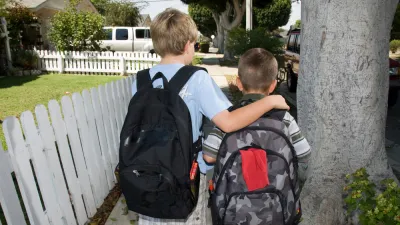Susan Elkin points to alarmingly low statistics on the number of children who walk to school, especially when compared with historic rates. She lays out some “blindingly obvious” and “child-centered” reasons why this trend needs to be reversed.

Elkin writes, “[a] study from the University of Westminster has this week shown that only 25 per cent of primary school pupils now travel home alone as opposed to 86 per cent in 1971 and 76 per cent today in Germany.” She outlines five reasons why it should be normal rather than exceptional for children to walk to school without parental supervision. These five reasons address issues such as: increasing child obesity, child development and socialization, stress- and risk-management, and even the observation of nature. Aside from these, Elkin points to a few others, including benefits to parents, car maintenance, and road congestion.
She also addresses, and debunks, the safety fears that prevent parents from allowing their children to walk to school. For example, she sites NSPCC statistics, which show that children are more likely to be killed by their own parents than by a stranger. On teaching kids about the rules of the road, she adds, “Surely if a parent walks his or her child to school until he or she is, say, eight there will have been ample time to do this?”
Elkin concludes by challenging parents to “break the mould” and to move away from “the hop-in-the-car attitude” that has become “culturally embedded” causing children to “[get] fatter, less curious and less self reliant."
FULL STORY: Only 25 per cent of children walk to school alone compared to 86 per cent in 1971. What went wrong?

National Parks Layoffs Will Cause Communities to Lose Billions
Thousands of essential park workers were laid off this week, just before the busy spring break season.

Retro-silient?: America’s First “Eco-burb,” The Woodlands Turns 50
A master-planned community north of Houston offers lessons on green infrastructure and resilient design, but falls short of its founder’s lofty affordability and walkability goals.

Delivering for America Plan Will Downgrade Mail Service in at Least 49.5 Percent of Zip Codes
Republican and Democrat lawmakers criticize the plan for its disproportionate negative impact on rural communities.

Test News Post 1
This is a summary

Test News Headline 46
Test for the image on the front page.

Balancing Bombs and Butterflies: How the National Guard Protects a Rare Species
The National Guard at Fort Indiantown Gap uses GIS technology and land management strategies to balance military training with conservation efforts, ensuring the survival of the rare eastern regal fritillary butterfly.
Urban Design for Planners 1: Software Tools
This six-course series explores essential urban design concepts using open source software and equips planners with the tools they need to participate fully in the urban design process.
Planning for Universal Design
Learn the tools for implementing Universal Design in planning regulations.
EMC Planning Group, Inc.
Planetizen
Planetizen
Mpact (formerly Rail~Volution)
Great Falls Development Authority, Inc.
HUDs Office of Policy Development and Research
NYU Wagner Graduate School of Public Service





























